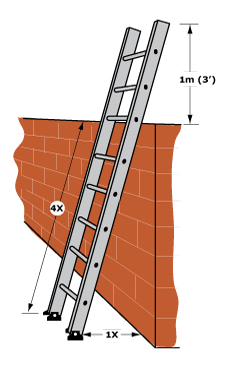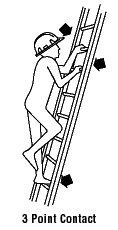Ladders – Portable – Fact Sheets
WHAT ARE PORTABLE LADDERS?
Portable ladder is a ladder than can be easily moved or carried. Portable ladders are available in various grades: light duty or grade 3; medium duty or grade 2; heavy duty or grade 1.
What should you know about portable ladders before using them?
Falls from portable ladders are a major source of serious injury. Be aware of the hazards and take proper precautions to prevent falling.
Incidents/accidents involving ladders are usually caused by:
- Using the wrong ladder for the specific job.
- Using ladders that are defective or in poor condition.
- Improper care or use including incorrect positioning, not securing the ladder properly, placing on poor footing, etc.
- Workers not being trained adequately to maintain, use or work from ladders safely.
What should you do before using a portable ladder?
- Use a ladder designed for your task. Consider the strength, type, length and the Canadian Standards Association (CSA) approval.
- Read and follow all the labels and markings on the ladder.
- Inspect the ladder before and after each use.
- Reject and tag any ladders that have defects. Have faulty ladders repaired or thrown out.
- Get help when handling a heavy or long ladder.
- Keep ladders away from power wires.
- Tie off extension or straight ladders at the top and secure bottom to prevent them from slipping.
- Set up barricades and warning signs when using a ladder in a doorway or passageway.
- Before mounting a ladder, clean the boot soles if they are muddy or slippery. Avoid climbing with wet soles. Ensure that footwear is in good condition.
- Face the ladder when going up or down and when working from it.
- Keep the centre of your body within the side rails.
What should you avoid when using a portable ladder?
- Do not use a ladder in a horizontal position as a scaffold plank or runway.
- Do not carry objects in your hands while on a ladder. Hoist materials or attach tools to a belt.
- Do not work from top three rungs. The higher a person goes on a ladder, the greater the possibility that the ladder will slip out at the base.
- Do not use items such as a chair, barrel or box as a makeshift ladder.
- Do not use a portable ladder when other equipment and safe means of access is available. Replace a ladder with a fixed stairway or scaffold.
- Do not join two short ladders to make a longer ladder. Side rails are not strong enough to support the extra load.
- Do not paint wooden ladders. Defects may be hidden by the paint. Wood preservatives or clear coatings may be used.
How should you set up the ladder?
- Place the ladder feet 1/4 of the ladder’s working length (i.e. distance to top support point) away from the base of the structure (e.g., for every 1.2 m (4 ft ) high, the base of the ladder should be out 0.3 m (1 ft); that means one horizontal foot from the support point).

- Extend the ladder at least 1 m (3 ft) above the landing platform or the point of support.
- Place the ladder on a firm, level footing. Use a ladder with slip-resistant feet or secure blocking. Brace or tie the bottom of the ladder.
- Rest both side rails on the top support and secure ladder to prevent slipping.
What should you know about climbing portable ladders?
- Check for overhead power lines before setting up a ladder.
- Clear area around base and top of the ladder of debris, tools and other objects.
- Wear a safety harness and tie the lanyard off to a proper anchor (e.g., designed fixed support, temporary fixed support, or existing structural feature or equipment) when working 3 m (10 ft) or more off the ground or when working with both hands. Make sure that you have been trained on how to use fall protection devices safely.
- Tie off yourself with a safety harness when working 3 m (10 ft) or more off the ground or when working with both hands.
- Ensure that only one person is on a single-width ladder. Only one person is allowed on each side of a double-width ladder.
- Maintain three-point contact by keeping two hands and one foot, or two feet and one hand on the ladder at all times.
- Grasp the rungs when climbing a ladder, not the side rails. If your foot slips on a ladder, holding onto rungs is easier than holding onto the side rails.

- Wear protective footwear with slip-resistant soles and heels.
- Ensure that all electrical equipment used during ladder work is in good condition and properly grounded.
- Rest frequently to avoid arm fatigue and disorientation when the work requires you to look up and reach above your head.
- Drape your arms over a rung and rest your head against another rung or side rail if you become dizzy or panicky. Climb down slowly.
What should you avoid when climbing portable ladders?
- Do not use ladders when a safe means of access is available and practical.
- Do not use a ladder in passageways, doorways, driveways or other locations where a person or vehicle can hit it. Set up suitable barricades or lock the doors shut.
- Do not place a ladder against flexible or moveable surfaces.
- Do not straddle the space between a ladder and another object.
- Do not erect ladders on boxes, carts, tables, scaffold or other unstable surfaces.
- Do not use ladders on ice.
- Do not stand a ladder on any of its rungs. Ladders must rest on both side rails.
- Do not allow anyone to stand under a ladder.
- Do not support ladders on their rungs.
- Do not overreach from a ladder; move as required.
- Do not use any type of ladder near overhead power lines unless the safe distance is maintained.

Source: © Copyright 1997-2021 CCOHS